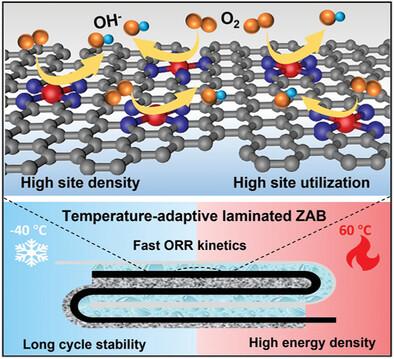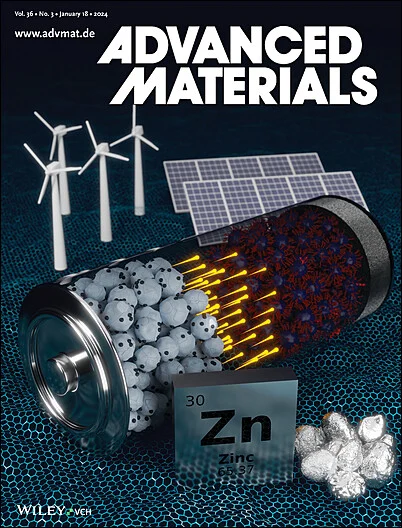High-Density Accessible Iron Single-Atom Catalyst for Durable and Temperature-Adaptive Laminated Zinc-Air Batteries
IF 27.4
1区 材料科学
Q1 CHEMISTRY, MULTIDISCIPLINARY
引用次数: 0
Abstract
Designing single-atom catalysts (SACs) with high density of accessible sites by improving metal loading and sites utilization is a promising strategy to boost the catalytic activity, but remains challenging. Herein, a high site density (SD) iron SAC (D-Fe-N/C) with 11.8 wt.% Fe-loading is reported. The in situ scanning electrochemical microscopy technique attests that the accessible active SD and site utilization of D-Fe-N/C reach as high as 1.01 × 1021 site g−1 and 79.8%, respectively. Therefore, D-Fe-N/C demonstrates superior oxygen reduction reaction (ORR) activity in terms of a half-wave potential of 0.918 V and turnover frequency of 0.41 e site−1 s−1. The excellent ORR property of D-Fe-N/C is also demonstrated in the liquid zinc-air batteries (ZABs), which exhibit a high peak power density of 306.1 mW cm−2 and an ultra-long cycling stability over 1200 h. Moreover, solid-state laminated ZABs prepared by presetting an air flow layer show a high specific capacity of 818.8 mA h g−1, an excellent cycling stability of 520 h, and a wide temperature-adaptive from −40 to 60 °C. This work not only offers possibilities by improving metal-loading and catalytic site utilization for exploring efficient SACs, but also provides strategies for device structure design toward advanced ZABs.

求助全文
约1分钟内获得全文
求助全文
来源期刊

Advanced Materials
工程技术-材料科学:综合
CiteScore
43.00
自引率
4.10%
发文量
2182
审稿时长
2 months
期刊介绍:
Advanced Materials, one of the world's most prestigious journals and the foundation of the Advanced portfolio, is the home of choice for best-in-class materials science for more than 30 years. Following this fast-growing and interdisciplinary field, we are considering and publishing the most important discoveries on any and all materials from materials scientists, chemists, physicists, engineers as well as health and life scientists and bringing you the latest results and trends in modern materials-related research every week.
 求助内容:
求助内容: 应助结果提醒方式:
应助结果提醒方式:


